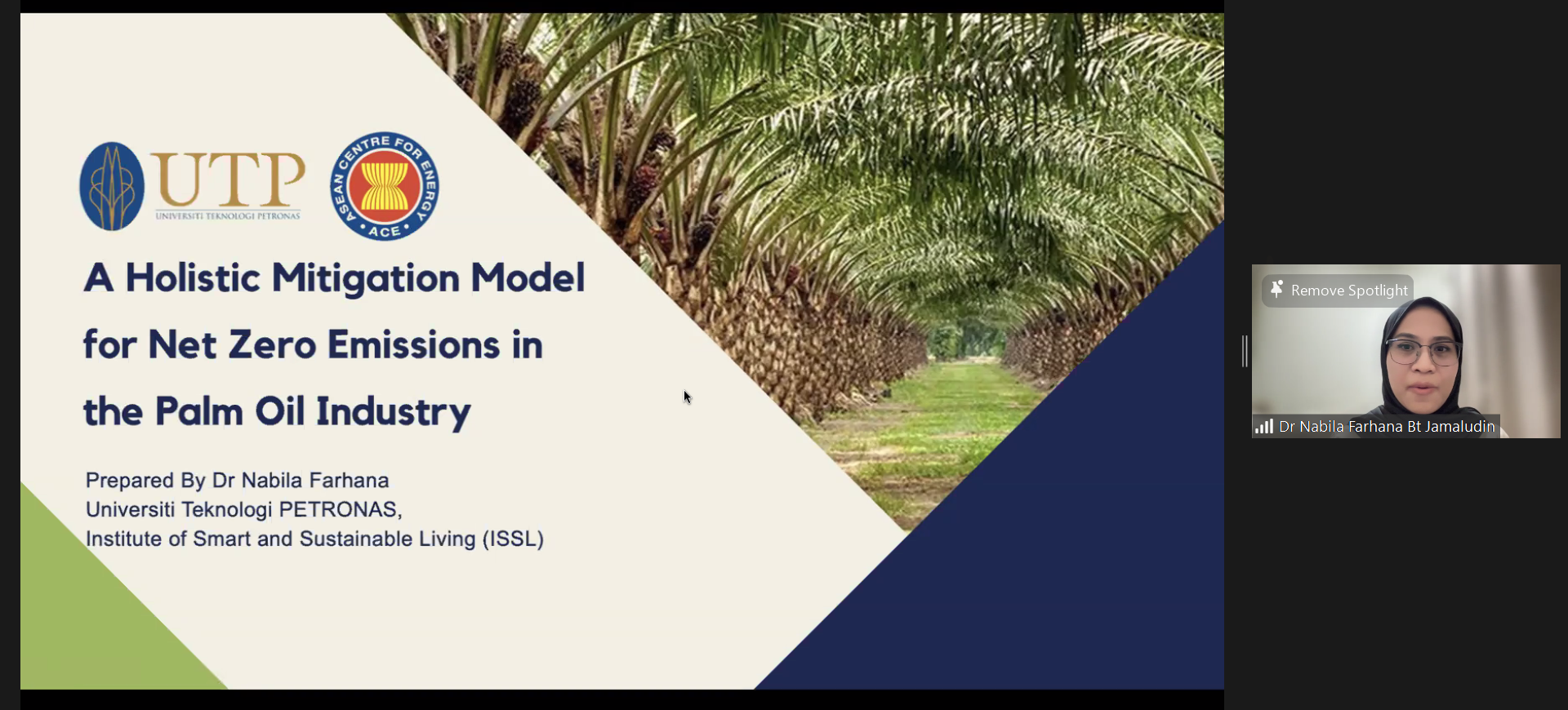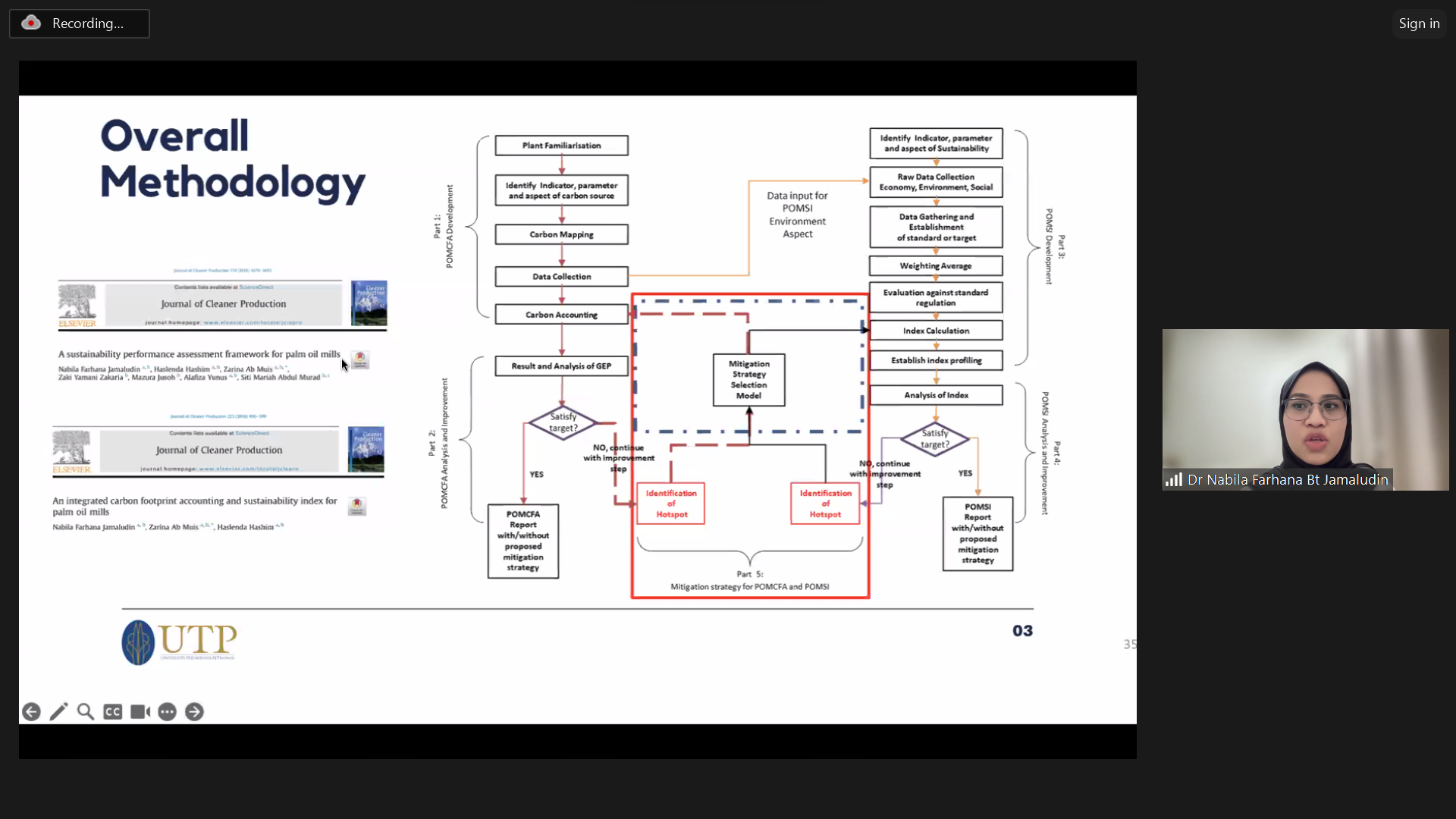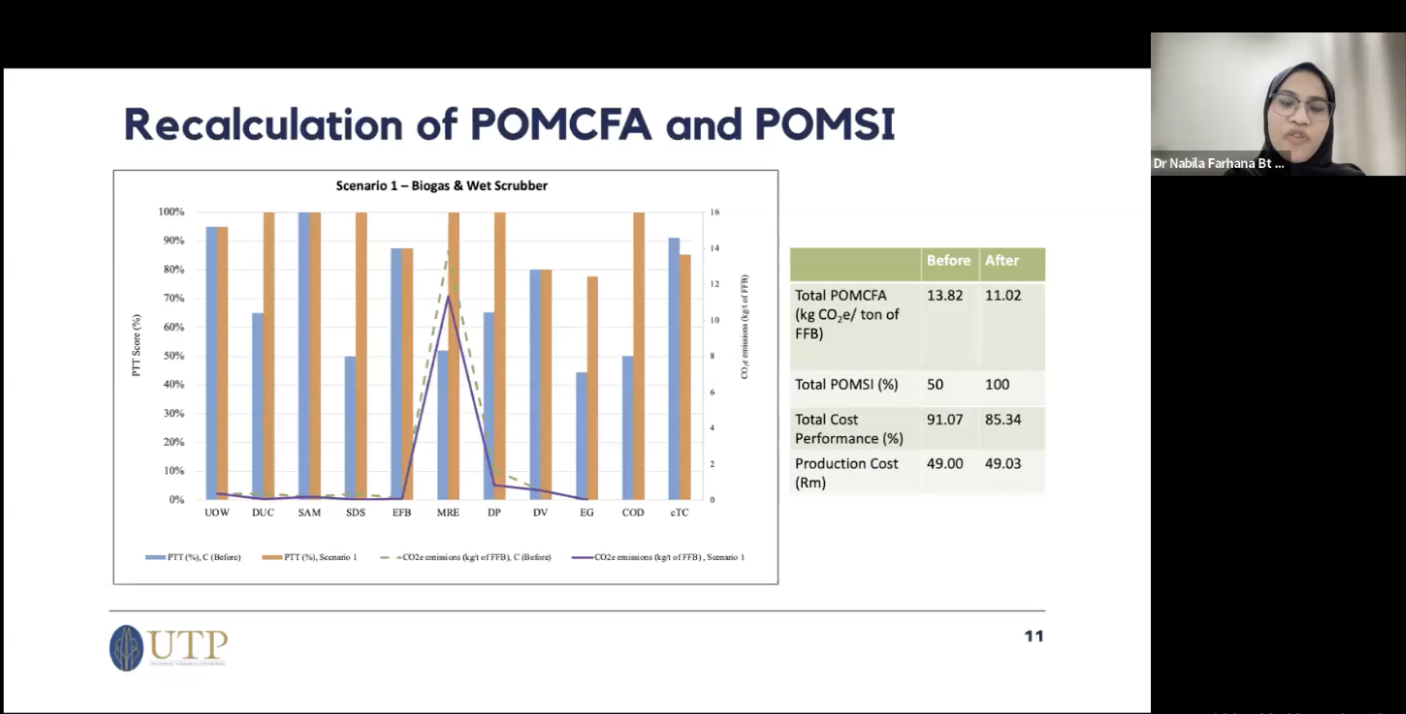i
i
Online, 28 March 2024

Photo 1 Dr Nabila Farhana presented her recent publication, “A Holistic Mitigation Model for Net Zero Emissions in the Palm Oil Industry”
The palm oil industry in Malaysia plays a vital role towards the nation’s economy. Yet. the critics evolves on environmental impact and greenhouse gas emissions remains. Although the government has initiated several policies and initiatives to promote sustainable palm oil, the continuous effort required to achieve a holistic and integrated mitigation strategy, which will help to facilitate decision-making in improving the performance. The product of palm oil is diversely used in various sector including transportation, food, cosmetics, etc.
ASEAN Climate Change and Energy Project (ACCEPT) Phase II welcomed the fifth episode of ARNECC Paper Talks moderated by Veronica Ayu from the ASEAN Centre for Energy. ACCEPT II invited a distinguished speaker, Dr. Nabila Farhana from Universiti Teknologi Petronas to share her recent publication, “A Holistic Mitigation Model for Net Zero Emissions in the Palm Oil”. With the invaluable economic value of the palm oil sector to Malaysia’s economy, the paper sets more inclusive standards to support the national aspiration en route to net zero emissions.

Photo 2 Dr Nabila presented the model development methodology for creating a mitigation model
The webinar held virtually on March 28, 2024, discussed the framework of the holistic mitigation model based on the Palm Oil Mill Carbon Accounting and Sustainability Index (POMSI). The model uses the superstructure approach, which outlines mitigation options to improve the weak indicators through assessments. Her study shows that the existing GHG emission reduction strategies have neglected the economic aspects and need to be grasped completely. The superstructure framework designs the sustainability indicators, which cover mitigation options with (m), to the mill indication, (n). These mitigation options are linked based on the choices, improvements, technology or alternatives to improve the existing indicators. In evaluating the economic value, the paper adopts the mathematical equations to assess the overall cost upon considering the investment cost (IC), the production cost (PC), and the variable cost (VC). The calculation evolves around the emission, consumption and yield.
Adopting the General Algebraic Modelling System, the system has proposed the biogas plant and wet scrubber. Dr Nabila Farhana outlined three scenarios. In the first scenario, where both biogas and wet scrubber are adopted, the POMSI score, has doubled from 50% (previously) to 100%, with the CO2 emission slightly reduced by 2.80kg/ton. However, the adoption of this mitigation option has led to the total cost performance reduced from 91.07% to 85.34% with production cost differ by RM0.03.

Photo 3 Dr Nabila presented the mitigation model based on the Scenario 1, both biogas plant and wet scrubber applied
In Scenario 2, the mitigation presence is only biogas. As a result, the POMSI score surged twice while the POMCFA similar to Scenario 1. There are relatively low differences in cost production by RM0.02 and the total cost performance reduced from 91.07% to 85.36%. In contrast, in Scenario 3, with the adoption of wet scrubber mitigation, the POMSI result remains due to the mix raw effluent (MRE) is high, and the CO2 emission shows a slight reduction by 0.82%. Despite the ideal result, the trade-off of the scenario is that the incurred cost is relatively high, and hence, it may result in a rise in the price of palm oil.
Overall, the model provides the analysis on mitigation planning, support decision making and the optimalisation to achieve net zero in Malaysia’s palm oil industry. It is concluded that the best technology is to have a biogas plant and wet scrubber to reduce GHG emission in the palm oil industry in Malaysia. However, it is also dependent on the financial aspect to adapt the technologies at the same time. Dr Nabila Farhana mentioned that it is also important to set a clear standard for the technologies that is still align with the regulation. In the regional level, the model is applicable for all AMS, but to have specific requirements, geographic condition and the supply and demand should be considered.
In the Q&A session, Dr Nabila conferred the objective and constraints should be set to ensure balance between economic viability and environment sustainability. A question raised by a representative from CNG Analytica to address the standards, such as RSPO are included in the study. Dr Nabila Farhana stated the standards are taken into account in designing the mitigation model study. Besides, she addressed that the POMCFA standard does not scope the GHG emissions based on Scope 1, Scope 2 and Scope 3. Instead, the standard quantifies the GHG emission overall. She added there could be future research to assess the GHG emissions tailored to the GHG scoping, which can help to provide more specialised mitigation options. In addition, she expressed the need for data management to improve the decision-making in selecting mitigation actions, and the palm oil industry can also leverage technological advancement to progress. Lastly, she emphasised other ASEAN countries adopt the holistic mitigation model but if there are other parameters, there is a need to customise the mathematical equations.
Key takeaways from webinar are the mitigation model helps to facilitate decision making for the palm oil mill and supports the optimisation towards achieving the net-zero carbon.
(IB)
Join our ASEAN Researchers Network on Climate Change (ARNECC) by registering yourself here. Become a part of our collaborative efforts to address pressing climate challenges and shape a sustainable future.
Detailed information on ACCEPT II can be found at https://accept.aseanenergy.org/
We welcome any future collaboration, please feel free to contact us at [email protected]